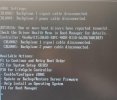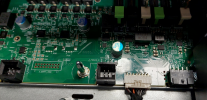Hi
I ve seen a different way to pass disks to a VM when an hba card is out of a question for some reason. You find the id (disk-by-id) of the drive (which doesn t change like sda sdb...etc) and you pass it through to the VM with the command
Even though it works and the VM sees the drives, what about the smart data of the disks passed through to the VM this way? Asking because there was a debate of whether or not disks will be recognized as virtual disks and therefore disk information will not be displayed. As a matter of fact at the disk's page of TrueNas, serial number column is empty. Wouldn t that cause confusion when one of the disks needs to be changed? You need to manually write down which disk corresponds to da0 da1 ...etc.
I ve also seen the disks passed through as -virtio(1,2,3....n) instead of iscsi(1,2,3...n) I don t know if that matters or not, or on which cases you use iscsi or virtio or sata ...etc. Can you elaborate on this?
PS: My use case scenario is an R730 with 16 sas drives on an embedded hba330 mini monolithic. Problem is that the backplane is an expander and can t pass through the onboard hba contoller because I need the 8 of those drives as a VM storage(will be created inside proxmox) and the other 8 are needed to be passed to the virtualized TrueNas. Complicated plan but due to the company's budget, not much I can do with a separate machine for True Nas.
I ve seen a different way to pass disks to a VM when an hba card is out of a question for some reason. You find the id (disk-by-id) of the drive (which doesn t change like sda sdb...etc) and you pass it through to the VM with the command
Code:
qm set id_of _the_vm -iscsi(0,1,2,3....n) /dev/disk/disk-by-id/ata-serial_of_disk-some_numberI ve also seen the disks passed through as -virtio(1,2,3....n) instead of iscsi(1,2,3...n) I don t know if that matters or not, or on which cases you use iscsi or virtio or sata ...etc. Can you elaborate on this?
PS: My use case scenario is an R730 with 16 sas drives on an embedded hba330 mini monolithic. Problem is that the backplane is an expander and can t pass through the onboard hba contoller because I need the 8 of those drives as a VM storage(will be created inside proxmox) and the other 8 are needed to be passed to the virtualized TrueNas. Complicated plan but due to the company's budget, not much I can do with a separate machine for True Nas.
Last edited:



